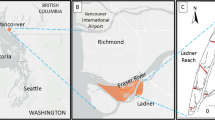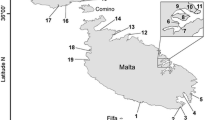Abstract
Although Phragmites has been an upper border tidal marsh species for thousands of years, it is only recently (within the last century or so) that the distribution of this plant within the coastal marsh community has become prominent. Prior to approximately 100 years ago, Phragmites was an upper border/brackish marsh co-dominant in many marsh systems. Occurrence of this species varied between associations of sedges, Typha, forbs and a variety of woody shrubs. Paleoreconstructions rarely show the presence of a Phragmites monoculture or early associations with salt marsh species. However, since the turn of this century (and perhaps as early as the middle of the last century) the distribution of Phragmites has changed substantially. Today, this plant often forms dense monocultures and is commonly found in association with Spartina grasses. The results of this paleoecological investigation show that the changes that have been observed in Phragmites communities during the last 100 years are not part of the long-term cycle of development in these systems and are new to the landscape.
Similar content being viewed by others
References
Besitka MR (1996) An ecological and historical study of Phragmites australis along the Atlantic coast. Masters Thesis, Department of Bioscience and Biotechnology, Drevel University, Philadelphia, Pennsylvania, 57 pp
Bjork S (1967) Ecologic investigations of Phragmites communis: Studies in theoretical and applied limnology. Folia Limnologica Scandinavica 14: 1–248
Bloom AL and Stuiver M (1963) Submergence of the Connecticut coast. Science 139: 332–334
Casagrande DG (ed) (1997) Restoration of an urban salt marsh: An interdisciplinary approach. Yale School of Forestry and Environmental Studies Bulletin No. 100, New Haven, Connecticut, 270 pp
Chambers RM, Mozdzer TJ and Ambrose JC (1998) Effects of salinity and sulfide on the distribution of Phragmites australis and Spartina alterniflora in a tidal salt marsh. Aquatic Botany 62: 161–169
Harrison EZ and Bloom AL (1977) Sedimentation rates on tidal marshes in Connecticut. Journal of Sedimentary Petrology 47: 1484–1490
Haslam SM (1970) The performance of Phragmites communis, Trin. in relation to water supply. Annals of Botany 34: 866–877
Haslam SM (1973) Some aspects of the life history and autecology of Phragmites communis, Trin.: a review. Polskie Archiwum Hydrobiologii 20: 79–100
Keene HW (1971) Postglacial submergence and salt marsh evolution in New Hampshire. Maritime Sediments 7: 64–68
McNabb CD and Batterson TR (1991) Occurrence of the common reed, Phragmites australis, along roadsides in lower Michigan. Michigan Academician 23: 211–220
Miller WR and Egler FE (1950) Vegetation of the Wequetequock-Pawcatuck tidal marshes. Ecological Monographs 20: 143–172
Muhlenberg H (1813) A catalogue of the native and naturalized plants of North America. William Hamilton Printer, Lancaster, Pennsylvania
Niering WA and Warren RS (1974) Tidal marshes of Connecticut: Vegetation, micro-relief and environmental impacts. In: Niering WA and Warren RS (eds), Tidal Wetlands of Connecticut, pp 1–69. Report to the Connecticut DEP, Hartford, Connecticut, Vols I and II
Niering WA, Warren RS and Weymouth C (1977) Our dynamic tidal marshes: Vegetation changes as revealed by peat analysis. Connecticut Arboretum Bulletin No. 22, New London, Connecticut, 12 pp
Orson RA (1996) Some applications of paleoecology to the management of tidal marshes. Estuaries 19: 238–246
Orson RA and Howes BL (1992) Salt marsh development studies at Waquoit Bay, Massachusetts: Influence of geomorphology on long-term plant community structure. Estuarine, Coastal and Shelf Science 35: 453–471
Orson RA, Niering WA and Warren RS (1987) The development of a New England river valley tidal marsh. Estuaries 10: 20–27
Orson RA, Warren RS and Niering WA (1998) Interpreting sea level rise and rates of vertical marsh accretion in a southern New England tidal salt marsh. Estuarine, Coastal and Shelf Science 47: 419–429
Portnoy JW and Giblin AE (1997) Effects of tidal restrictions on salt marsh sediment chemistry. Biogeochemistry 36: 275–303
Redfield AC and Rubin M (1962) The age of salt marsh peat and its relation to recent changes in sea level at Barnstable, Massachusetts. Proceedings of the Natural Academy of Sciences 48: 1728–1735
Roman CT, Niering WA and Warren RS (1984) Salt marsh vegetation change in response to tidal restriction. Environmental Management 8: 141–149
Soil Survey Staff (1975) Soil Taxonomy. US Department of Agriculture, SCS Agricultural Handbook, Washington, DC, 436 pp
Torrey J (1826) Compendium of the Flora of the Northern and Middle States. Stacy B. Collins Printers, New York
Warren RS and Niering WA (1993) Vegetation change on a northeast tidal marsh: Interaction of sea level rise and marsh accretion. Ecology 74: 96–103
Author information
Authors and Affiliations
Rights and permissions
About this article
Cite this article
Orson, R.A. A Paleoecological Assessment of Phragmites australis in New England Tidal Marshes: Changes in Plant Community Structure During the Last Few Millennia. Biological Invasions 1, 149–158 (1999). https://doi.org/10.1023/A:1010047731369
Issue Date:
DOI: https://doi.org/10.1023/A:1010047731369




